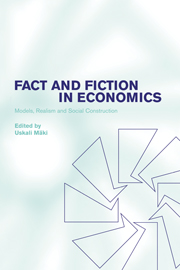Book contents
- Frontmatter
- Contents
- Notes on the contributors
- Preface
- I Introduction
- II Setting the scene
- III Economic models and economic reality
- 5 Credible worlds: the status of theoretical models in economics
- 6 The limits of causal order, from economics to physics
- 7 Econometrics and reality
- 8 Models, stories, and the economic world
- 9 Economic models and reality: the role of informal scientific methods
- 10 Truthlikeness and economic theories
- IV The constitution of economic reality
- V The institutions of economics
- Index
- References
8 - Models, stories, and the economic world
Published online by Cambridge University Press: 22 September 2009
- Frontmatter
- Contents
- Notes on the contributors
- Preface
- I Introduction
- II Setting the scene
- III Economic models and economic reality
- 5 Credible worlds: the status of theoretical models in economics
- 6 The limits of causal order, from economics to physics
- 7 Econometrics and reality
- 8 Models, stories, and the economic world
- 9 Economic models and reality: the role of informal scientific methods
- 10 Truthlikeness and economic theories
- IV The constitution of economic reality
- V The institutions of economics
- Index
- References
Summary
It is conventional among philosophers of science to think of models in their relation to theory, and thus to concentrate on the model–theory relationship. Here I want to concentrate on the relation of models to the world. In this chapter I claim that the way models help us to describe and to understand the economic world we live in is by telling stories about the world. That story may be a story about the real world (past, present or future), or it may be a story about the hypothetical world portrayed in the model: the relationship of the story to the model structure is the same. Modeling involves a style of scientific thinking in which the argument is structured by the model, but in which the application is achieved via a narrative prompted by an external fact, an imagined event or question to be answered. Economists use their economic models to explain or to understand the facts of the world by telling stories about how those facts might have arisen. The stories are neither “merely heuristic” nor “just rhetoric” but an essential part of the way models are labeled and used.
The story so far
There are two accounts in which stories figure prominently in the methodological literature on models in economics. First, chronologically, we have the account by Gibbard and Varian (1978). They claim, in one of the few philosophical accounts of models in economics, that stories are an integral part of the way models work.
- Type
- Chapter
- Information
- Fact and Fiction in EconomicsModels, Realism and Social Construction, pp. 178 - 201Publisher: Cambridge University PressPrint publication year: 2002
References
- 13
- Cited by



